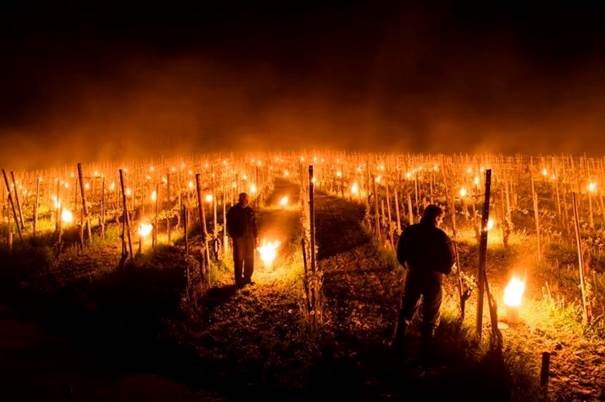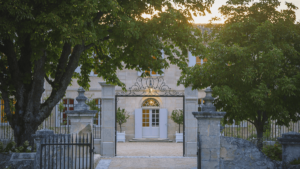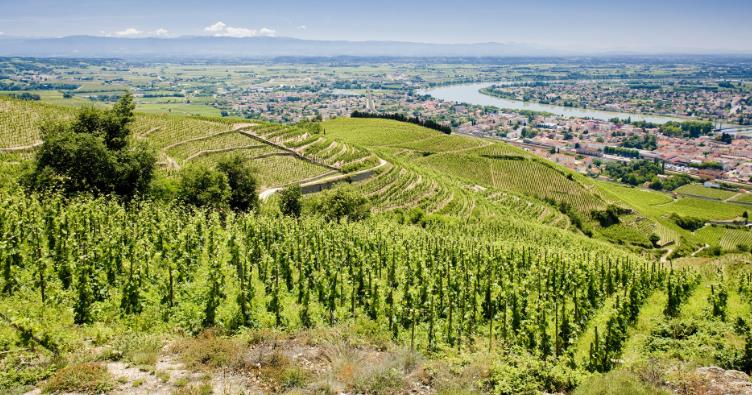
Crozes-Hermitage, Cornas and Saint-Joseph are familiar names to many wine enthusiasts. But which appellation will best suit your tastes? Which wines should be aged? Which ones can be enjoyed sooner? This is a guide to help you navigate the famous Rhône Valley, and the first part is an exploration of the North.
As is the case for many of the world’s viticultural regions, it is a river that gives its name to the wine-growing land around it. The source of the Rhône is located in the Swiss Alps and runs all the way to the Mediterranean Sea at the Camargue delta. 812 kilometres in length, it crosses regions of extremely varied climates. When we speak of the Rhône Valley and its vineyards, this refers to the last 300 kilometres of the river. It is thus not surprising to find some similarities between the vineyards of Switzerland, Savoy and the Northern Rhône Valley.
The Rhône Valley – border between northern and southern wine production
One of the Rhône Valley’s most interesting characteristics is that it acts as a linking region between northern viticulture (single-varietal, sloped vineyards) and that of the south (blends of different varieties grown on the plains). This difference justifies the distinction made between the northern Rhône (meaning from south of Lyon to Valence) and the southern Rhône (between the south of Montélimar and Nîmes). It should also be noted that there is, in fact, essentially a border between these two regions, since there is aspace of around 50km between them where there are no vines at all. The Rhône mainly produces red wine (79% of the 2.5 hectolitres) but the 6% of white wines are not to be underestimated.
In this first part, let’s take a look at the Northern Rhône. This viticultural region is a narrow strip mainly planted on the right bank of the river. A large amount of the production is reserved for crus. Out of the region’s two AOCs (Côtes-du-Rhône and Côtes-du-Rhône Villages), only the first can be produced in the northern Rhône, even though this is rare. The IGP wines of the Rhône hills are preferred by producers to specify that they aren’t southern Côte-du-Rhône.
Rhône Valley grape varieties
The red variety:
Syrah: The only red grape variety grown in this part of the Rhône Valley, Syrah flourishes on the steep slopes of the northern region, from which it draws all of its sophistication. Once vinified, it delivers typical aromas of black fruits, pepper, and floral notes such as violet. The winemakers have a choice between different vinification and élevage containers. Syrah can give very different results depending on the terroir: delicate and fine from Blonde de Côte-Rotie, powerful with animal notes from Cornas and Côte-Rôtie’s côte brune. The long-held tradition is to plant Syrah with white varieties, and some winemakers have continued this practice.
The white varieties:
Viognier: An aromatic grape variety carrying apricot notes that gives full-bodied wines. Condrieu is its terroir of choice. Whilst some cuvées are to be enjoyed young and fruity, the greatest successes are marked with a lovely minerality that prepares them well for ageing.
Marsanne: Generally blended with Roussanne. It gives fine, sophisticated wines with great structure and low acidity. For the Hermitage appellation, this is the preferred white variety.
Roussanne: Usually blended, it gives aromatic wines with notes of yellow fruit like peach. In Savoy, it is also called Bergeron.
Crus from the Northern Rhône Valley
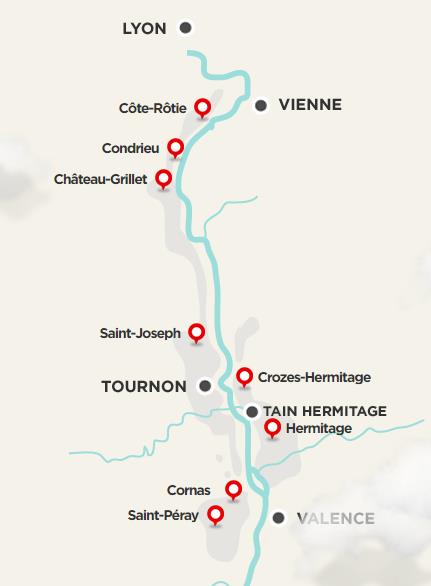
Côte-Rôtie
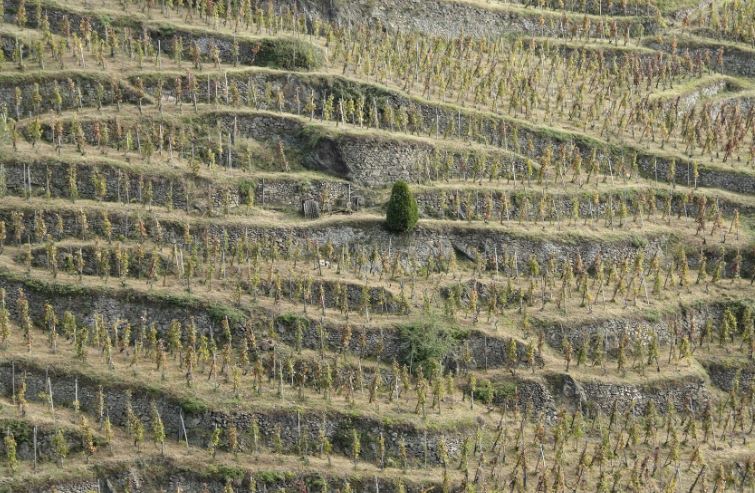
This is now one of the most keenly sought-after appellations in the world. But with 276 hectares on an incredibly steep slope that can reach up to a 60° angle (we call the ‘terraces’ that overlook the Rhône chaillets), it is also a viticultural zone that’s impossible to mecanise, therefore carrying the most expensive maintenance costs globally. The appellation produces only red wine. We can distinguish two principle terroirs: Côte Blonde, composed mainly of light granite that gives fine, delicate wines, and Côte Brune, named after its schist soils, rich in iron oxide. Here, the wines are much more powerful than those from the Côte Blonde. The only red grape variety permitted here is Syrah, though there is often up to 20% Viognier found in the final blend.
Figuring among some of the finest French reds, bottles of Côte-Rôtie are to be enjoyed after 10-30 years of ageing (for the finest cuvées). There is no official hierarchy of the appellation’s terroirs. Producers are free to blend the terroirs they wish (La Turque and La Mouline from Guigal are like this, not expressing one particular terroir). But some localities are particularly sought-after, such as La Landonne and Les Grandes Places.
Among the best producers, Guigal (with its LA-LA-LA trilogy), Gangloff, and the unmissable Stéphane Ogier should be cited. At iDealwine, we are also fans of Clusel-Roch, François Villard and the more attainable cuvées from Vignobles Levet. There is also the finesse of Domaine Othéguy‘s wines to mention. All of these and more can be enjoyed with dishes such as bacon and potatoes.
Condrieu
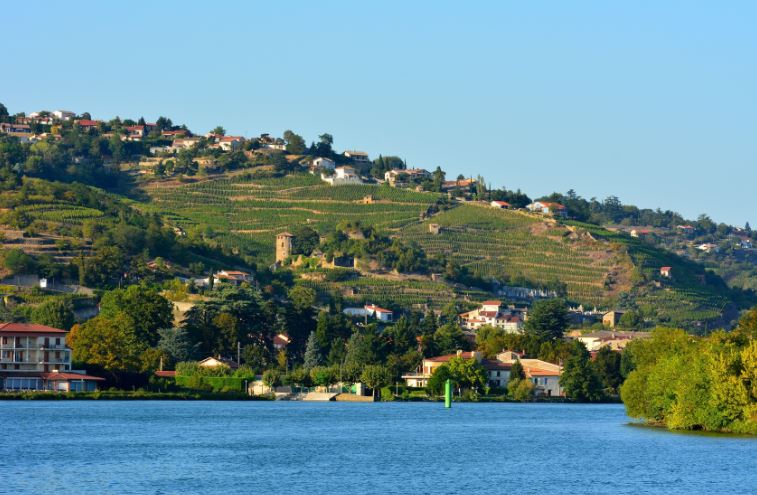
This appellation, just to the south of Côte-Rôtie, produces only white wines. The aromatic Viognier grape finds its terroir of choice here. Condrieu’s speciality is to offer a powerful, mineral imprint that responds well to the wine’s body and intense fruitiness.
To enjoy after 3-4 years of ageing, the finest cuvées can wait up to 25 years. It pairs well with a famous COndrieu Rigotte cheese.
It’s impossible to talk about Condrieu without mentioning Georges Vernay, the ‘Pope of Condrieu’ who saved a vineyard abandonede by its owners after the war. His daughter, Christine, has now taken up the torch with great success. Côteau de Vernon is one of the finest whites in France. Some of the biggest Côte-Rôtie names (Guigal, Gangloff, Villard) are some of the appellations best producers.
Château Grillet
This is the smallest Rhône appellation (just 3.5 hectares). It is worked by the teams that are also owners of Château Latour in Pauillac and Domaine Eugénie in Burgundy (Pinault group). Château Grillet is an enclave at the heart of the Condrieu appellation. The wine is very mineral, highly sophisticated, and should be enjoyed in 15-30 years’ time.
Saint-Joseph
The most spread-out Rhône appellation, Saint-Joseph is planted on the right bank of the river and measures 80km in length from Chavenay to Guilherand, covering 1200 hectares. The appellation has its origins in 6 villages located around Mauves before extending further to the north. So, then, they were known as ‘Mauve wines’. It is mainly Syrah reds that are produced here, though there are also some whites (Marsanne and a bit of Roussanne). The highest-quality terroirs are still located in the south of the appellation: Mauves, Tournon, Glun etc. The reds are well-balanced and quite firm. The whites can also be of great quality.
The level here is rather heterogenous, but some terroirs are absolutely exceptional, with steep slopes, giving intense reds. Depending on the terroir, these wines reward 5-15 years of ageing.
At iDealwine, we’ve dsicovered some gems, including Domaines Aléofane and Stéphane Othéguy which will continue to make people talk. There are also some safe bets like Combier, Villard and Coursodon.
Crozes-Hermitage
Crozes produces reds from Syrah and whites from Roussanne and Marsanne. This appellation looks to the south of Saint-Joseph, since along with Hermitage it is the only one of the left bank, and is mainly on the plains. The red wines are full-bodied, rounder than at Saint-Joseph, and have medium aeing potential. But some winemakers are contributing to the impressive increase in the range of the wines.
At iDealwine, we particularly love Domaine des 4 Vents (formerly Domaine de Lucie), as well as unmissable names like Graillot and Jaboulet Ainé.
Hermitage
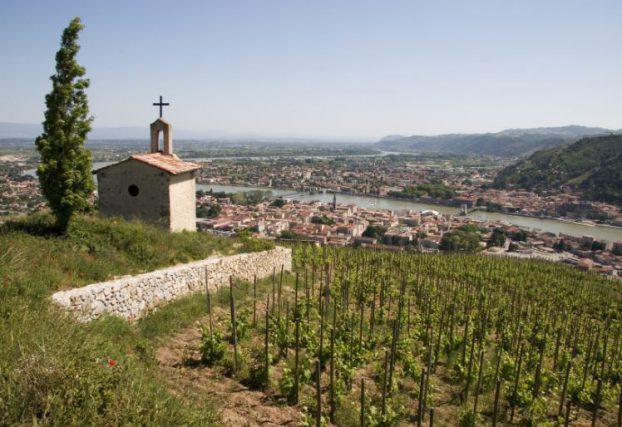
This is like the Crozes grand cru, in a way. This 120-hectare appellation is located on the Tain-L’Hermitage hill. It overlooks the entire Rhône Valley, benefitting from magnificent terroirs and exceptional exposure. It produces some of the finest reds in the world, like La Chapelle de Jaboulet, which owes its name to the Chevalier de Sterimberg who withdrew to become a hermit in a little chapel at the top. It will pair well with meat dishes, particularly beef. The white wines, more understated, show themselves to be equally high-calibre. Does ‘Montrachet du Sud’ ring a bell? In any case, they should be kept to enjoy at the table with crustaceans like lobster.
The whites can be aged for 15-25 years, and the reds for more than 15.
The most famous producers, apart from Maison Jaboulet, are Chapoutier and Domaine Jean-Louis Chave.
Cornas
For a long time, this has been the sleeping beauty of the northern Rhône, but now it is waking up. the only appellation fo the northern Rhône to refuse all white grape varieties, its wines are powerful, spicy, and made to be aged. A young generation of winemakers have managed to draw yet more finesse from this exceptional terroir, producing especially concentrated wines. Bottles from here should be aged for 10-20 years. The appellation’s success is growing, and iDealwine can only advise that you get stock your cellar with some Cornas cuvées as soon as possible!
The best producers are Auguste Clape, Alain Voge and Thierry Allemand. And keep an eye on Domaine du Tunnel.
Saint-Péray
This little appellation (75 hectares) only makes gentle, sparkling whites of great quality from Marsanne and Roussanne grapes. The wines are full (yellow fruits, citrus) but balanced all the same. To be enjoyed in 2610 years’ time.
Numerous Cornas producers also have vineyards in Saint-Péray like the brilliant Alain Voge.
See the Rhône wines available at iDealwine
See all of our wines here


